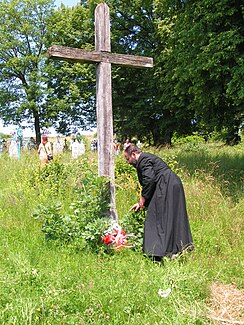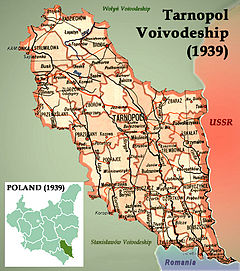
Around six million Polish citizens are estimated to have perished during World War II. Most were civilians killed by the actions of Nazi Germany, the Soviet Union, the Lithuanian Security Police, as well as the Organization of Ukrainian Nationalists and its offshoots.

The Massacres of Poles in Volhynia and Eastern Galicia were carried out in German-occupied Poland by the Ukrainian Insurgent Army (UPA), with the support of parts of the local Ukrainian population, against the Polish minority in Volhynia, Eastern Galicia, parts of Polesia, and the Lublin region from 1943 to 1945.

In July 1941, 25 Polish academics from the city of Lwów along with the 25 of their family members were killed by Nazi German occupation forces. By targeting prominent citizens and intellectuals for elimination, the Nazis hoped to prevent anti-Nazi activity and to weaken the resolve of the Polish resistance movement. According to an eyewitness the executions were carried out by an Einsatzgruppe unit under the command of Karl Eberhard Schöngarth with the participation of Ukrainian translators in German uniforms.

Wiktor Poliszczuk was a Polish-Ukrainian-Canadian political scientist specialising in the history of political thought, who wrote about the Polish-Ukrainian relations during World War II and issues relating to the emergence of Ukrainian nationalism in the 20th century resulting in a campaign of ethnic cleansing. Poliszczuk's work has been praised by several Ukrainian, Polish, Canadian, American, and Ukrainian historians, but also acknowledged for his Polish-Ukrainian reconciliation effort.
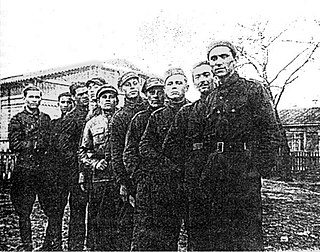
The Naliboki massacre was the 8 May 1943 mass killing of 127 or 128 Poles by Soviet partisans in the small town of Naliboki in German-occupied Poland.

The Huta Pieniacka massacre was a mass murder of the Polish inhabitants of the village Huta Pieniacka, located in modern-day Ukraine, which took place on February 28, 1944. Estimates of the number of victims range from 500 to 600-800 to 1,200.

Zygmunt Jan Rumel was a Polish poet and, during World War II, underground officer of the Bataliony Chłopskie partisans in the Wolhynia Region of the Second Polish Republic. Rumel's poetic talent was acknowledged by renowned Polish poet Leopold Staff and dramatist Jarosław Iwaszkiewicz. One of his poems entitled "Dwie matki" in which Rumel described his love of Poland and Ukraine, was published in a popular Płomyk magazine in 1935. He was killed by the Ukrainian Insurgent Army during the massacres of Poles in Volhynia in 1943.
The village of Adamy was burned to the ground during the Massacres of Poles in Volhynia and Eastern Galicia, and no longer exists. It was destroyed by the Ukrainian Insurgent Army aided by the Ukrainian peasants who set ablaze 200 Polish farms and murdered whomever they could find. Adamy was located in powiat Kamionka Strumiłowa (county) near Busk in the Tarnopol Voivodeship of the Second Polish Republic before the Nazi-Soviet invasion of Poland in 1939.
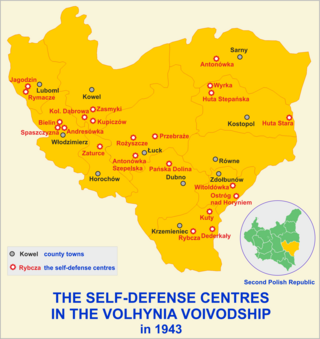
Stara Huta is a village in northwestern Ukraine, in Kovel Raion of Volyn Oblast, but was formerly administered within Stara Vyzhivka Raion. The population of the village is 1024 people.

Tadeusz Bohdan Isakowicz-Zaleski was a Polish Roman Catholic and Armenian Catholic priest, author and activist. He was a leader of the anticommunist student opposition in Kraków in the late 1970s, became a Solidarity chaplain in Kraków's Nowa Huta district in the 1980s, and later an avid supporter of the lustration of the Polish Church. On 3 May 2006, he was awarded the Commander's Cross of the Order of Polonia Restituta, one of Poland's highest orders. Subsequently, in 2007, he was awarded the Order of the Smile and the Polish Ombudsman's Order of Paweł Włodkowic.
Massacre of Wola Ostrowiecka was a 1943 mass murder of Polish inhabitants of the village of Wola Ostrowiecka located in the prewar gmina Huszcza in Luboml County of the Volhynian Voivodeship, within the Second Polish Republic. Wola Ostrowiecka no longer exists. It was burned to the ground during the Massacres of Poles in Volhynia and Eastern Galicia.
The Ostrówki massacre was a 1943 mass murder of the Polish inhabitants of the Volhynian village of Ostrówki, located in the gmina Hushcha, Liuboml, Volhynian Voivodeship in the Second Polish Republic. On 30 August 1943, armed members of the Ukrainian Insurgent Army (UIA) murdered 438 Poles. Among the victims were 246 children under the age of 14.

The Podkamień massacre or the Pidkamin massacre of 12 March 1944 was the massacre of Polish civilians committed by the Ukrainian Insurgent Army (UPA) under the command of Maksym Skorupsky (Maks). The victims were ethnic Polish residents of Podkamień, Tarnopol Voivodeship. During the war the area was administratively part of the Nazi German Reichskommissariat Ukraine. Estimates of victims include 150, more than 250 and up to 1000.
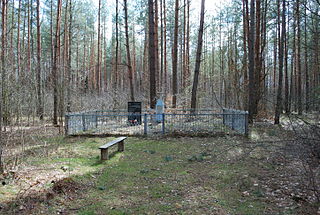
The Parośla I massacre was committed during World War II by the Ukrainian Insurgent Army (UPA) under the command of Hryhorij Perehijniak "Dowbeszka-Korobka" on 9 February 1943 against the ethnic Polish residents of the village of Parośla in the Nazi-controlled Reichskommissariat Ukraine. It is considered a prelude to the ethnic cleansing of Poles in the Volhynia region by the UPA, and is recognized as the first mass murder committed by the Ukrainian Insurgent Army in the area. Estimates of the number of victims range from 149 to 173.
Czarny Las massacre was a mass murder of around 250–300 ethnic Poles during World War II, carried out by the Gestapo on the orders of SS-Hauptsturmführer Hans Krueger in Czarny Las near Stanisławów, the night of August 14/15, 1941.
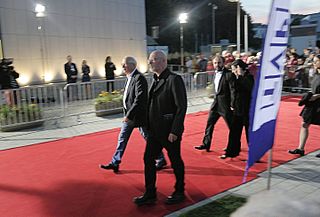
Volhynia or Hatred is a 2016 Polish war drama directed by Wojciech Smarzowski. The film is set in the 1939–1943 time frame and its central theme is Ukrainian anti-Polish hatred culminating in massacres of Poles in Volhynia. The screenplay was based on the collection of short stories titled Hate by Stanisław Srokowski.
The Wiązownica massacre occurred on 17 April 1945 in the village Wiązownica, located in Jarosław County Subcarpathian Voivodeship, in southeastern Poland, then located in Lwów Voivodeship. It was one of the Massacres of Poles in Volhynia and Eastern Galicia, and was perpetrated by the Ukrainian Insurgent Army (UPA). The massacre occurred during a battle fought between the UPA and, initially, local Polish partisans, and, later, the Polish People's Army (LWP), towards the outskirts of Wiązownica. It saw the deaths of 91 civilians, including 20 women and children, alongside four LWP soldiers. The UPA also burned down 150 houses. In retaliation for the attack, the LWP led an attack on the village Piskorowice, given its large concentration of Ukrainians sympathetic for OUN.

The Sochy massacre occurred on 1 June 1943 in the village of Sochy, Lublin Voivodeship in Zamość County, Lublin Voivodeship during the German occupation of Poland when approximately 181–200 of its inhabitants, including women and children, were massacred by the German Ordnungspolizei and SS in retaliation for the village's support for the Polish resistance movement.

The Mausoleum of the Martyrdom of Polish Villages in Michniów is a museum located in Michniów, in Świętokrzyskie Voivodeship, in Poland, constituting a branch of the Museum of the Kielce Village, commemorating the pacification actions in German-occupied Poland.
The Polish–Ukrainian conflict was a series of armed clashes between the Ukrainian guerrillas and Polish underground armed units during and after World War II, namely between 1939 and 1945, whose direct continuation was the struggle of the Ukrainian underground against the Polish People’s Army until 1947, with periodic participation of the Soviet partisan units and even the regular Red Army, as well as the Romanian, Hungarian, German and Czechoslovak armed formations. The fighting initially took place in the south-east areas of the Second Polish Republic occupied by the Third Reich and later in the Rzeszów Voivodeship, south-east parts of the Lublin Voivodeship of the Polish People’s Republic and in the west areas of the Ukrainian Soviet Socialist Republic. There was also sporadic activity in the Romanian-occupied territories.
